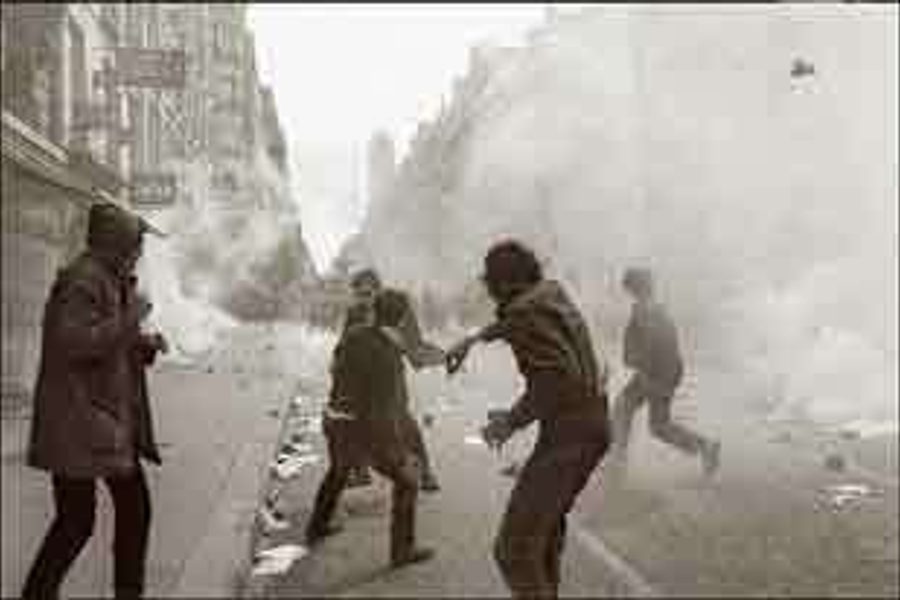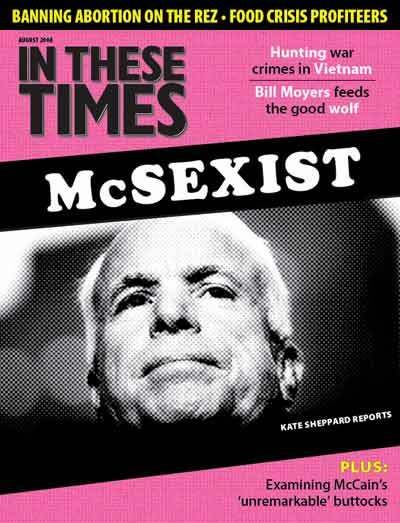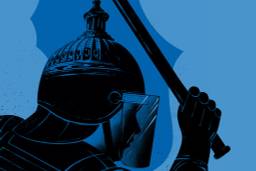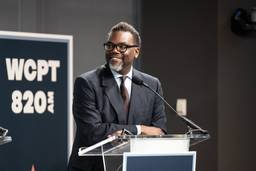
The protests of 1968 – symbolically, the occupation of the Columbia University buildings, the student uprisings in Paris and the street protests in Berlin – are now in danger of being denigrated as the actions of spoiled, confused, if not neurotic, students and rebellious youth who were “finding” themselves in making trivial demands of their uncomprehending and benevolent societies.
An April 23 op-ed by Paul Auster in the New York Times calls 1968 “the year of the crazies.” Another op-ed, by Jean-Claude Guillebaud, on May 24, calls the protesters “useful idiots,” and the current attention on them a “frenzy of nostalgia.”
In the process, the serious changes brought about by the events of ‘68, the substance of the protests, the reasons for the discontent, and the desire for change, are either ignored or superciliously dismissed as childish daydreams.
Even Slavoj Žižek, in the July issue of In These Times, quotes with approval French psychoanalyst Jacques Lacan’s comment about the students of ‘68: “As revolutionaries, you are hysterics who demand a new master. You will get one.”
That that much was, in fact, achieved is beyond doubt.
The Columbia protests stopped both military research at the university and the construction of a gym in a park that was seen by Harlem and its black residents as an insult by a rich, dominant institution.
Internationally, the ‘68 protests changed the character of post-war politics, helped end the Vietnam War, and legitimized concerns about peace, welfare and democracy beyond the prevailing mainstream consensus.
Underlying the student protests was a deep dissatisfaction with things as they were: the acceptance of violence, the discrimination, the consumerism, the competitive pursuit of wealth and power, the false virility, the hypocritical sexual mores, the environmental degradation, the commercialization of art and imagination, the production of one-dimensional people. The desire for love as a central component of life – love both in its erotic and in its humane sense, brotherly and sisterly love among all people – was a powerful motivating force.
But the nature of the dissatisfactions and the aspirations behind them deserve a closer examination.
Surprisingly, those aspirations for a just and humane society are not far from those on which the United States and the French revolutions were based more than two centuries ago: “life, liberty and the pursuit of happiness,” and “liberty, equality, fraternity.” These claims have run through the history of the modern world, and have been the sources of major protests against the three great social evils of exploitation, domination and discrimination.
In the American Revolution, “life” meant the satisfaction of material needs. That’s what motivated the Boston of Sam Adams and what roused, in the spirit of equality, the colonial farmer.
“Liberty” in the United States meant freedom from domination from abroad, and in France meant freedom from an entrenched feudal system.
“Fraternity” – later “sorority,” or better yet, “solidarity” – spoke to relations between people, not simply formal justice but also human relations. It was this claim of fraternity, coupled with a belief in equality, that lay behind the slave rebellions, the Civil War and later the civil rights movement, in which the exploitation and domination that racism supported were necessarily also targets of the struggle.
“The pursuit of happiness,” however, added something different. “Life, liberty and the pursuit of happiness” is Thomas Jefferson’s modification of philosopher John Locke’s phrase “life, liberty and property” – a solidly liberal and now conventional formulation.
It is stretching a point to think that in writing “the pursuit of happiness,” Jefferson might have had in mind the claims of the ’60s protesters. But while the connection may be more logical than historical, it is nonetheless symbolically provocative.
The ’60s did add a new ingredient to the conventional liberal demands of the earlier centuries – claims made possible by technological promises of plenty and prosperity that were based on a system in which exploitation, domination and racism were concealed but nevertheless central.
The ‘68 movement targeted the one-dimensionality that was the result of a system in which profit was derived from never-ending competition and never-ending growth.
The protesters thought there was hope for revolutionary change because this system contains the means for its own undoing: It produces technologies that enable the fulfillment of authentic human needs to an extent never before possible – and without the necessity of manufacturing inauthentic needs for material consumption to keep the system going.
With this new awareness, new demands were expressed in action. (Historically, those aspirations were not new; the Lawrence textile strikers in Massachusetts put “Bread and Roses” on their placards in 1912.) These new claims took seriously the “pursuit of happiness” both as a social goal and as a personal one. They were the foundations of the ’60s protests.
The earlier claims were included: the right to equality in opposition to discrimination was successfully addressed with broad civil rights legislation and political reform. The acceptance of more widespread democratic participation in politics extended liberty. And opposition to domination ended the Vietnam War under the claim for justice and liberty.
Separately, these were each major reforms. They came together as anti-colonial revolutions in Africa, Asia and Latin America.
The students occupying Columbia University buildings – protesting a university gym preempting a public park, accepting the leadership of African-American youth, and opposing the use of university resources for research into technologies of death – symbolized the earlier and the new sensibility.
The students were deeply disturbed at the difficulties of providing an adequate material life, in the face of the reality of increasing inequality in the distribution of goods and services. But they added to that a demand to expand the possibilities for the pursuit of happiness, both as individuals and collectively, although the claim was often rather inchoate, and expressed more theoretically and philosophically than politically.
So, no political revolutions resulted from the actions of the demonstrators in the streets of Berlin, New York and Paris – or in Detroit, Los Angeles and Montgomery. Major reforms, yes, but the idealistic aspirations were abortive.
They responded to the one-dimensionality of the world around them, and linked their dissatisfaction to the antiwar and civil rights movements, but not politically to the third source of protest – exploitation.
Symptomatic of this was the attitude of the police in the Columbia buildings occupation. They treated the students as elitist brats enjoying the luxuries of an expensive education that a working policeman could never aspire to. The common nexus that connected the students’ aspirations for freedom and happiness to the limits on material opportunities of exploited workers did not come together.
In France, workers were directly engaged, but the bulk of the trade union leadership withheld support from the broader aspirations, refusing to see connections where doing so would have interfered with more pragmatic considerations.
In May 1968, a columnist for Le Nouvel Observateur wrote of Paris:
It was the strike, not the student revolt, that truly paralyzed the country for three long weeks. The paradox is that these two movements never encountered each other. The students marching toward the factories to “meet the workers” found the doors closed. The unions didn’t want them: the workers found the students disorganized and irresponsible.
The New Left tried to put all claims together and in context, but in the end failed. The system was too strong, was able to deliver the goods to meet ever-increasing, artificially created needs and consumerist desires, and provided enough satisfaction to thwart the emergence of even deeper demands. The reforms that were achieved were limited not by the weakness of the students and the protesters of the ’60s, but by the strength of the system that they critically engaged.
By 1968, the advances that a technologically oriented industrial society had opened up were, in a technical sense, revolutionary. They created a possibility of a world without want, a world in which necessary uncreative labor was reduced to a bare minimum, in which restraints on liberty and blocks to fraternity were no longer required for growth, in which there was no need to repress love that might interfere with economically more desirable motivations – a world in which, in a manner of speaking, utopias were no longer utopian but were technically feasible.
Realizing this, as many of the protests of ‘68 did, put the possibility of meeting new claims – such as for the achievement of happiness – on the historical agenda, and on the global stage.
For the first time in history, the possibility of achieving the full goals of the 18th century revolution existed, and the students and protesters of ‘68 were the first to raise it in the arena of political and social action.
However, the formulation of these new demands ignored one simple thing: the system – which had delivered the goods to many of the students and their supporters, enabling them to formulate these newly realizable aspirations – had not delivered the goods in like manner to everyone.
Many workers, the unemployed and poorly paid, members of ethnic or racial minorities, and many women were excluded from the benefits of the new abundance, as were huge numbers in the Third World. Their struggles were for the minimal level of equality that would let them participate in the acquisition of the goods being delivered to others. Žižek, writing in In These Times, calls them the Excluded, differentiating them from the Included, such as the students and many of those on the New Left.
As a consequence, a conflict appeared between the demands of the ‘68 protesters and the large number of those whose demands could be seen as a prerequisite for pursuing the claims of the new sensibility. In other words, a disconnect occurred between the needs of the Included and the needs of the Excluded.
That disconnect was little addressed in theory, and it perhaps prevented the ferment of the ’60s from achieving either side’s goals.
But there were glimmers of a realization of the problem: in the calls of the civil rights movement not only for full participation in the existing system but also for reform of that system as in the calls of the Rev. Martin Luther King Jr. at the end of his life:
We have moved into an era where we are called upon to raise certain basic questions about the whole society. We are still called upon to give aid to the beggar who finds himself in misery and agony on life’s highway. But one day, we must ask the question of whether an edifice which produces beggars must not be restructured and refurbished. That is where we are now. (Speech to the leadership of the Southern Christian Leadership Conference, Frogmore, May 1967.)
When Žižek stresses the importance of “the destructured masses” and attention to “the Excluded,” but criticizes the French suburban riots of 2005 as “an outburst with no pretense to vision,” he is right. But the lesson that needs to be drawn is to forge the link between the resistant members of the Included – the students and intellectuals of ‘68 and their successors today – and the Excluded – the exploited workers of the majority of the world, including the French suburban rioters in 2005 and of African Americans and Latinos of the United States. But the unification of the two is not easy in practice.
We have seen a perverse reflection of the failure to unite the sources of protest in the current election campaign. In caricature, Sen. Hillary Clinton’s (D-N.Y.) primary campaign drew on the demand for sorority, and Sen. Barack Obama’s (D-Ill.) on that for racial equality. Both campaigns dealt, with various levels of directness, with the exploitation of workers.
But Obama also draws on another sensibility – that greed is dehumanizing, that broader changes in human relations and conduct are needed, that there is something missing in everyday life that goes beyond a mere paycheck and a middle-class standard of living. Perhaps calling it a real chance at the pursuit of happiness is too rhetorical, but that is what it harkens back to.
Clinton tried to convince voters that this was elitist, of interest only to the Included, and she tried to convince those who endure exploitation – whose daily lives are insecure, whose needs and anxieties are day-to-day, who may in fact really be bitter, the Excluded – that Obama and his greater vision come at the expense of neglecting their immediate crises.
Former White House adviser Karl Rove saw the difference in similar, if cruder, terms. He wrote in the May 16 Wall Street Journal: “The primary has created a deep fissure in Democratic ranks: blue collar, less affluent, less educated voters versus the white-wine crowd of academics and upscale professionals (along with blacks and young people).”
In diluted form, this is precisely the problem that 1968 raised for the first time in efforts for major social change in the United States: on the one hand, the connection between the immediate needs of those still struggling for the basics, and, on the other hand, the hopes for a fuller, richer life that others, largely better positioned, want to pursue.
The two together constitute a call to implement the “inalienable right to life, liberty and the pursuit of happiness” that the Declaration of Independence claimed more than 200 years ago, that the idealistic protesters of 1968 were after, and that Obama must succeed in unifying if he is to advance the change he is talking about.
It is a set of goals still well worth fighting for. And we should honor the activists of 1968 for their contributions to it, not dismissively denigrate them.





